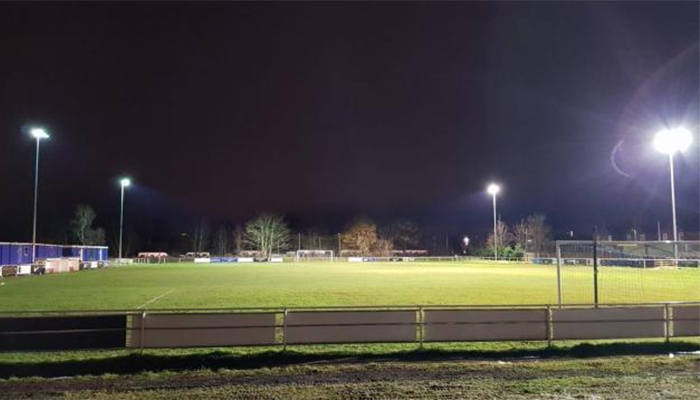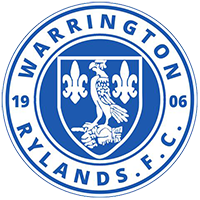
Emblematically Speaking - Rylands
Tue 22nd January 2019 | Warrington Rylands 1906 | By Stewart Taylor
Not for the first time in this series of excursions into the meaning of club emblems we find ourselves having to speculate somewhat as to the mindset of the designers of the emblem when contemplating a pictorial way of depicting their football club.
We will have a go at this and, as has often proved to be a useful source of information, go back to the origins of the club to see if that leads us to some informed speculation.
We start with an old friend of this series the River Mersey. The making of the River Mersey into a navigable waterway paved (not quite the right word in the context of a river!) the way to the industrialisation of Warrington.
The town developed quite a diverse industrial base but the main industry was the manufacture of wire which eventually led to the nickname “The Wire” as adopted by both the Rugby League team and Warrington FC.
One of the main wire manufacturers of wire was Rylands Brothers which was established in the east of the town in the early part of the 19th century.
Rylands FC were established in 1911 as, essentially, the works team and play at the Rylands Recreation Club.
Many of our readers will have travelled to one or more of the many Miners Welfare Clubs over in South Yorkshire, Derbyshire and North Nottinghamshire for FA Cup and FA Vase matches, so will be familiar with sporting teams being supported by a large local employer as in this case.
So, we have established the origins of the club so we can then look into the individuals who established the company from which the football club derives its identity.
This further study takes us to the very origins of the Rylands Brothers company which was originally established as John Rylands and Son. And now for a small diversion.
One of the most iconic buildings in Central Manchester is John Rylands Library – an Edwardian structure of great architectural merit on Deansgate. On discovering that a John Rylands was referenced in the story of Rylands FC it would be reasonable to at least investigate if there were any links.
Sadly, I can’t find any direct links which is a real shame as I now have no excuse for describing in considerable detail this fabulous building – maybe one day!
But back to the story and, indeed, the emblem. Given the above we might expect to find some references to the devices and colourways of the emblem in the history of the Rylands family.
A glance at the emblem shows a simple shield containing two devices underscored by a scroll indicating the name of the club all in yellow(gold) and black – so far so good. We have often found that the colours used in emblems reflect the playing colours of the club – not in this case as the first team colours are blue.
The main device in the centre of the shield shows a bird of prey on a gauntleted right hand with the first finger pointing to the left as we look.
The two devices either side of the bird of prey appear to be stylised architectural features or, maybe, the crest of an ecclesiastical mace or crook. Having said that, there is a resemblance to a fleur-de-lis and what we may be looking at is a simplified version of that emblem of many things including peace.
If we take this forward to any coats of arms associated with any member of this particular Rylands family we find nothing which helps in that these two devices are not seen on, for example, the coat of arms of Sir Peter Rylands – son of the founder of the company.
Equally, we might expect to find a cross reference in the coat of arms of Warrington, but we do not.
Investigations by the current officers of Rylands FC have suggested that the bird of prey is a falcon but, beyond that, nothing is known.
If falconry was one of the leisure activities offered at the Rylands Recreation Club at some time long ago, there is no readily available reference to that.
In conclusion, we started this exploration with something of a mystery and, largely, the mystery remains.
If any reader can add to the story then please get in touch. Any help would be much appreciated as we seek to add to the knowledge of the football club.
 Emblematically Speaking - Rylands
Emblematically Speaking - Rylands
Tue 22nd January 2019 | Warrington Rylands 1906
By Stewart Taylor

Not for the first time in this series of excursions into the meaning of club emblems we find ourselves having to speculate somewhat as to the mindset of the designers of the emblem when contemplating a pictorial way of depicting their football club.
We will have a go at this and, as has often proved to be a useful source of information, go back to the origins of the club to see if that leads us to some informed speculation.
We start with an old friend of this series the River Mersey. The making of the River Mersey into a navigable waterway paved (not quite the right word in the context of a river!) the way to the industrialisation of Warrington.
The town developed quite a diverse industrial base but the main industry was the manufacture of wire which eventually led to the nickname “The Wire” as adopted by both the Rugby League team and Warrington FC.
One of the main wire manufacturers of wire was Rylands Brothers which was established in the east of the town in the early part of the 19th century.
Rylands FC were established in 1911 as, essentially, the works team and play at the Rylands Recreation Club.
Many of our readers will have travelled to one or more of the many Miners Welfare Clubs over in South Yorkshire, Derbyshire and North Nottinghamshire for FA Cup and FA Vase matches, so will be familiar with sporting teams being supported by a large local employer as in this case.
So, we have established the origins of the club so we can then look into the individuals who established the company from which the football club derives its identity.
This further study takes us to the very origins of the Rylands Brothers company which was originally established as John Rylands and Son. And now for a small diversion.
One of the most iconic buildings in Central Manchester is John Rylands Library – an Edwardian structure of great architectural merit on Deansgate. On discovering that a John Rylands was referenced in the story of Rylands FC it would be reasonable to at least investigate if there were any links.
Sadly, I can’t find any direct links which is a real shame as I now have no excuse for describing in considerable detail this fabulous building – maybe one day!
But back to the story and, indeed, the emblem. Given the above we might expect to find some references to the devices and colourways of the emblem in the history of the Rylands family.
A glance at the emblem shows a simple shield containing two devices underscored by a scroll indicating the name of the club all in yellow(gold) and black – so far so good. We have often found that the colours used in emblems reflect the playing colours of the club – not in this case as the first team colours are blue.
The main device in the centre of the shield shows a bird of prey on a gauntleted right hand with the first finger pointing to the left as we look.
The two devices either side of the bird of prey appear to be stylised architectural features or, maybe, the crest of an ecclesiastical mace or crook. Having said that, there is a resemblance to a fleur-de-lis and what we may be looking at is a simplified version of that emblem of many things including peace.
If we take this forward to any coats of arms associated with any member of this particular Rylands family we find nothing which helps in that these two devices are not seen on, for example, the coat of arms of Sir Peter Rylands – son of the founder of the company.
Equally, we might expect to find a cross reference in the coat of arms of Warrington, but we do not.
Investigations by the current officers of Rylands FC have suggested that the bird of prey is a falcon but, beyond that, nothing is known.
If falconry was one of the leisure activities offered at the Rylands Recreation Club at some time long ago, there is no readily available reference to that.
In conclusion, we started this exploration with something of a mystery and, largely, the mystery remains.
If any reader can add to the story then please get in touch. Any help would be much appreciated as we seek to add to the knowledge of the football club.


